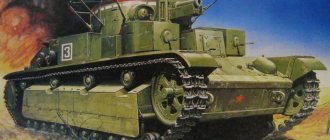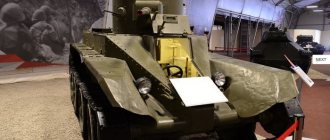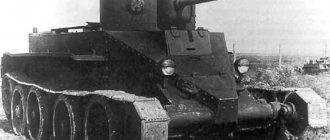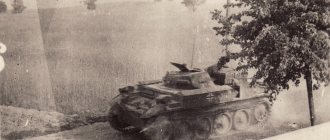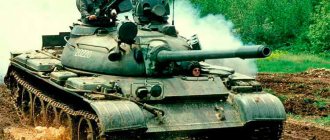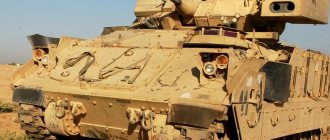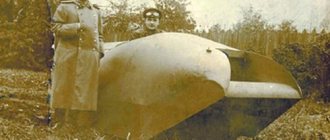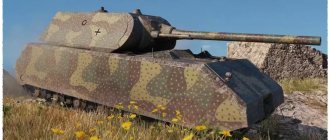MAIN TANK T-64
MAIN TANK T-64
The T-64 tank became the first combat vehicle of the so-called second generation of post-war Soviet tanks. Its development began in the first half of the 1950s and now, 50 years later, this machine evokes the most conflicting assessments among experts. From enthusiastic epithets “stage-by-stage” and “revolutionary” to harsh criticism of these very “stage-by-stage” and “revolutionary” qualities, which the country received at too high a price, and, moreover, are not controversial. However, first things first.
The initial concept of the new Kharkov tank was developed by the chief designer of KB-60 A.A. Morozov in 1953. At the same time, the tactical and technical characteristics of the tank were compared with the characteristics of the already aging T-54 tank, which was put into service in 1946. The essence of the concept was to increase firepower without changing the caliber of the gun, as well as increase armor protection and mobility by 10%. The weight of the tank was supposed to remain within 36 tons. It is worth especially noting that an integral part of the concept was the development of a completely new engine design for the tank.
Main tank T-64 (object 432).
The preliminary design of the tank, designated “object 430,” was ready by the end of 1954. The car had a classic layout and, in general, its design did not contain any revolutionary solutions, with the exception of the engine.
It was planned to install a horizontal two-stroke turbo-piston 4TPD diesel engine with counter-stroke pistons in the tank. Work on such engines began during the Great Patriotic War on the basis of Fairbanks-Morse diesel two-stroke diesel engines received under Lend-Lease from the USA. In combination with small-sized planetary onboard gearboxes, the use of this engine made it possible to reduce the volume of mechanical equipment by half compared to the T-54 tank. In addition, the tank was supposed to use an ejection cooling system instead of a fan one. The hull and turret had to have large angles of inclination of the armor parts, and the new 100-mm D-54TS tank gun was chosen as the main armament.
T-64A tanks on the march.
In 1955, the Decree of the Central Committee of the CPSU and the USSR Council of Ministers was issued, which finally legalized the use of a two-stroke H-shaped engine in the new tank. Its design was entrusted to the Kharkov plant named after Malyshev (plant number 75). At the plant, a design bureau for engines was created, the chief designer of which was A.D. Charomsky. All these steps are quite difficult to explain from the point of view of common sense, since in the “backlog” Charomsky had only an unfinished project for an aviation two-stroke diesel engine with oppositely moving pistons M-305. Using this “backlog”, the new design bureau began developing the 5TD tank engine with a power of 580 hp.
In July 1956, a technical design for the “Object 430” tank was developed in Kharkov. It took into account the comments of the Scientific and Technical Committee of the GBTU and the adjusted tactical and technical requirements. In 1957, two prototypes were made for factory testing, and then three more for military training grounds. From the very beginning of the tests, the unreliability of the 5TD engine was revealed. It turned out, for example, that at the most likely ambient temperatures (+25 °C and below), the engine cannot be started without preheating using a heater. In addition, many shortcomings were discovered in other components of the tank, including extremely unreliable operation of the lightweight chassis.
By 1960, comprehensive tests of several prototypes, carried out at the factory test site near Kharkov and at the 38th Research Institute in Kubinka near Moscow, showed that the “Object 430” was superior to the serial T-54 and T-55 tanks in its main indicators. However, this superiority was not so significant that it became advisable to adopt a fundamentally new combat vehicle.
The qualitative superiority of the new tank over the T-54 and T-55 was achieved only after installing the D-68 smoothbore 115-mm cannon with mechanized loading. Modified primarily in the areas of anti-nuclear and anti-cumulative protection, the tank received the designation “object 432”. The first prototype was manufactured in September 1962, the second in October. On October 22, at the training ground of the 38th Research Institute in Kubinka, a demonstration of new ground forces equipment to party and government leaders took place. The new Kharkov tank made a favorable impression on N.S. Khrushchev, who declared: “We will take it!” As a result, the tank did not pass field tests in full, and many shortcomings in its design were revealed during military service.
The first production tanks rolled off the assembly line at the Malyshev plant in October 1963. As of September 1964, 54 tanks were produced, and by December 1, 1965, 218 vehicles. Almost all of these tanks entered trial operation into the 41st Guards Tank Division, stationed in Chuguev, not far from Kharkov. This made it possible to provide the military with qualified factory assistance, which they desperately needed when mastering new, complex, capricious and unreliable machines.
T-64A.
Main tank T-64B.
“Object 432” was adopted for service by a resolution of the USSR Council of Ministers dated December 30, 1966 under the designation T-64. It was mass-produced until 1969.
The hull of the T-64 tank was welded from rolled armor plates located in the bow at large angles of inclination. The sides of the hull were vertical, with stampings in the middle part to increase the internal volume and install a turret. The turret was a shaped casting made of armored steel, to the top of which the roof was welded. The maximum armor thickness along the horizontal component (according to Western data) reached 815 mm for the hull and 460...627 mm for the turret.
The tank's turret was equipped with a 115-mm D-68 smoothbore gun, stabilized in two planes. The ammunition consisted of 40 rounds of separate-case loading, of which 30 were located in the conveyor of the loading mechanism in L-shaped cassettes. The shells were placed in cassettes horizontally with their “heads” to the axis of rotation. Charges with a partially burning cartridge case were installed vertically, with metal pallets facing up.
Protective casing for the antenna guidance device for KUV 9K112 “Cobra” missiles.
Main tank T-64B with installed KDZ.
A hydroelectromechanical type loading mechanism was mounted in the rear part of the turret. The ammunition included three types of shells: high-explosive fragmentation, armor-piercing sub-caliber and cumulative. After the gunner pressed the button of the selected ammunition on the control panel of the loading mechanism, the conveyor was rotated, the cassette was removed from the ammunition rack, the projectile and charge were turned in line and sent into the breech. After the shot, the catching mechanism captured the pallet and placed it in the vacated conveyor tray. Coaxed with the cannon was a 7.62-mm PKT machine gun with 2,000 rounds of ammunition.
The tank's power plant consisted of a 5TDF engine - a 5-cylinder, in-line, horizontal, two-stroke, liquid-cooled turbo-piston diesel engine with direct-flow purge, piston gas distribution, counter-moving pistons and double-sided power take-off. Engine power was 700 hp. at 2800 rpm.
The transmission is planetary with seven forward gears, one reverse gear and friction engagement. It consisted of two planetary final drives with coaxial planetary final drives.
The undercarriage for one side consisted of six double track rollers with internal shock absorption, four single support rollers, a rear drive wheel and a idler wheel. Individual torsion bar suspension. Hydraulic telescopic shock absorbers were mounted in the suspension units of the 1st, 2nd and 6th road wheels. The caterpillars are small-link steel with a 540 mm wide RMS and 78–79 tracks in each.
The engine, transmission and chassis allowed the vehicle weighing 36 tons to reach speeds of up to 65 km/h. Highway range up to 700 km (with additional fuel tanks). The tank crew consisted of 3 people.
Feeding mechanism:
1 — feed mechanism lever; 2 - executive cylinder; 3 - tray; 4 - right copier; 5 - projectile; 6 - charge; 7 - breech; 8 — pallet catching mechanism; 9—dispatching mechanism.
In 1963, in parallel with the design support of the serial production of the T-64, work began on installing a new 125-mm smoothbore tank gun D-81T (2A26) into this tank. The technical design of the tank, which was assigned the index “object 434,” was completed in 1964. In the same year, a pilot batch of 20 vehicles was produced, which underwent military testing in 1966–1967. In May 1968, the new tank was adopted by the Soviet Army under the designation T-64A.
Installation of the new gun required significant changes to the design of the turret and loading mechanism, as well as the replacement of day and night sights and a weapon stabilizer. The tank's combat weight increased to 37 tons. The capacity of the loading mechanism was reduced to 28 rounds, and the gun's ammunition capacity as a whole was reduced to 37 rounds. Subsequently, the NSVT-12.7 “Utes” anti-aircraft machine gun with remote control, a turret with an increased level of protection (combined armor with corundum filler), equipment for self-entrenchment, a mount for mounting the KMT-6 rutted knife mine trawl and built-in equipment for self-extraction were introduced , the “Brod” system for overcoming water obstacles up to 1.8 m deep without preparation, the “Mountain - Plain” system to ensure engine operation in high altitude conditions, the 902A “Cloud” smoke grenade launch system, etc.
The T-64B-1 tank with installed equipment for underwater driving and a manhole pipe overcomes a water obstacle.
In 1973, the Kharkov Mechanical Engineering Design Bureau (KMDB) began developing a technical design for the T-64A tank with missile-gun guided weapons and an improved fire control system (“object 447”). This tank differed from the T-64A primarily in the 125-mm cannon/launcher 2A46-2, which made it possible to fire 9M112 anti-tank guided missiles from the 9M112 Cobra guided weapon system. The missile had a semi-automatic control system, using a narrowly directed radio beam, in which the gunner-operator monitored only the target through an optical sight, and tracking of the missile and generation of control commands were carried out automatically by a guidance station installed in the fighting compartment of the tank.
The Object 447A tank was adopted by the Soviet Army in 1976 under the T-64B brand and code name Sosna. However, the increased cost did not allow all tanks to be equipped with a guided weapon system. Therefore, in parallel with the T-64B tank, its simplified version T-64B-1 (“object 437A”) was produced, distinguished by the absence of this complex. Until 1985, the T-64B and T-64B-1 tanks were produced together with the T-64A. As a result, in tank divisions, one regiment was often armed with T-64B tanks, another with T-64B-1 tanks, and a third with T-64A tanks. Some tank regiments were armed with all three types of tanks simultaneously.
In January 1985, variants of the T-64B and T-64B-1 tanks with “Contact” mounted dynamic protection kits of 179 metal containers installed on the turret and hull were put into service. There were 80 containers installed on the turret and 99 containers on the hull. The combat weight of the tank increased to 42.4 tons. Serial production of tanks, designated T-64BV and T-64BV-1, continued until 1987.
On the basis of the line ones, command tanks T-64K, T-64AK, T-64BK, T-64AKM were created and mass-produced. Using the T-64 chassis and transmission, the MT-T artillery tractors, the PTS-2 amphibious transporter, and the PMM-2M ferry-bridge vehicle were produced.
T-64 tanks of all modifications primarily entered service with tank formations of the Soviet Army stationed in the Group of Soviet Forces in Germany. In addition, they were present in some formations stationed in other groups of troops in Eastern Europe and on the territory of the European part of the USSR. At a military parade in Moscow, the 64s were shown only once - on May 9, 1985. These were T-64B-1 tanks. Data on the number of produced vehicles of the T-64 family were not provided in the domestic press. However, according to data announced by the Soviet side at the Vienna negotiations on the limitation of conventional weapons in Europe, in 1990 there were 3,977 T-64 tanks of all modifications on this continent.
T-64 tanks were not exported and did not take part in hostilities as part of the Soviet army. They received their baptism of fire after the collapse of the Soviet Union under unusual circumstances.
Training battle. In attack - T-64B-1.
T-64BV tank from one of the units of the 14th Army. Transnistria, June 1992.
In the spring of 1992, an armed conflict broke out in Transnistria. At first, the parties involved used only small arms. However, soon the Moldovan formations were able to significantly replenish their arsenal with weapons and military equipment transferred by the 14th combined arms army of the former Odessa Military District. The transfer was carried out as part of the division of property of the Soviet army between the former Soviet republics. In addition, the newly created Moldovan army received weapons from Romania. In particular, the Romanian side transferred armored personnel carriers and a batch of T-55 tanks. In turn, the Pridnestrovians had only a few units of military equipment at their disposal. They had nothing to oppose to the artillery shelling and attacks by armored vehicles from the Moldovan side.
In May 1992, after a three-day artillery shelling of the city of Dubossary, the patience of local residents ran out. A crowd of fifteen thousand stood in the way of the tank and motorized rifle companies of the 14th Army returning from the training ground. 10 T-64BV tanks and 10 BTR-70 armored personnel carriers were captured. An armored group was formed from local residents. She was thrown into an area from which there was intense shelling. The armored group managed to crush the Moldavian artillery. But there were some losses. One of the sixty-fours was set on fire by an unidentified anti-tank weapon. As a result, the ammunition detonated and the tank turned into a pile of scrap metal.
Sergei Vasilyevich Vukolov, a career tank officer who served in the Soviet army for 25 years, spoke about the formation of the armored group and its further combat use in his memoirs published in the newspaper Trudovoy Tiraspol.
“The big difficulty was that people knew only T-55 class vehicles, and were not at all familiar with modern T-64Bs, they are full of electronics, automation, that is, much more complex machines. All this could not but affect the training of crews.
Two tank companies were created. One was in combat positions in the Dubossary direction, and the second was trained at a training center and studied technology. Although, of course, it was difficult to accomplish anything in such a short period of time. The 2nd tank company was supposed to leave for the Dubossary direction on June 20. But on June 19, the Moldovan side sent its units into Bendery. After this, on June 20 at 2 a.m., the “White Acacia” signal sounded on our radio. Of course, everyone didn’t have time, so we had to form prefabricated crews. There was no coherence. I didn’t know many people at all.”
At 19.00 on June 19, Moldovan columns of armored personnel carriers, artillery, and T-55 tanks entered Bendery along the Chisinau and Kaushan highways. Within a few hours the city was occupied by the Moldovan army. Indiscriminate firing from all types of weapons led to a huge number of civilian casualties. Moldovan units carried out massive attacks on the building of the city executive committee, the barracks of the guards of the Pridnestrovian Moldavian Republic, and the city police department. At dawn on June 20, units of the Moldovan army captured the Bendery-1 station and the housing and social bank. The fire was conducted by tanks, self-propelled guns, and armored personnel carriers; Mortar shelling of the city was carried out from the village of Lipkani.
T-64BV tank destroyed on the outskirts of Bendery. Transnistria, June 1992. The tank's turret was torn off by an explosion of ammunition.
Seeing how the city was being destroyed, women from the Bendery Strike Committee captured several pieces of military equipment from the 59th Motorized Rifle Division of the Russian Army. Using this technique, the guards, Cossacks and militia from Tiraspol moved towards Bendery, crushing both Moldovan artillery batteries on the bridge, and made their way to the besieged building of the city executive committee. These tanks broke through the siege ring. The troops of the Republic of Moldova began to retreat randomly. By the morning of June 21, they controlled only two microdistricts of Bender and the suburban village of Varnitsa.
Recalls S.V. Vukolov: “Women took three tanks from the 14th Army at about five in the morning (that is, they stole them; simply put, they were “privatized” by the women’s strike committee). There were no machine guns on them. There were also malfunctions that greatly influenced the conduct of combat work. Let's say the mounting bracket for the machine gun box is torn off - that's already a problem. On old T-55 class vehicles, the tape could be loaded into the machine gun from either side, started from either end - and the machine gun worked. It didn't work that way here anymore. And the feed angle of the machine gun belt must be appropriate, and the appropriate placement of the belt in the machine gun boxes. It seems like all these are little things, but they played a big role in the attack. At the most critical moment, the machine gun began to jam and it stopped firing.
They received machine guns already in Parcani and launched an attack on the bridge. It was more of a psychic attack, although the tankers, of course, fulfilled their task with honor. Here I must note the following: the tank guys knew very well that going into battle in an unprepared vehicle was tantamount to death. But they went.
And we still had to take the bridge. Opponents armed to the teeth stood against us. Each one had fire weapons to combat tanks, there were also ATGMs and about a dozen 100-mm Rapier anti-tank guns. In practice, our idea was useless, but determination and courage - to go straight into battle - played a role. The bridge was taken."
In that battle, Vukolov’s tank fired several shots at Moldovan positions. The gunner tried to shoot down an enemy armored personnel carrier, but missed. The lack of aiming of the gun had an effect. Another target appeared - an armored vehicle, spraying the Pridnestrovians with fire from a heavy machine gun. Having made an adjustment, they hit it - the armored vehicle shattered into pieces. Then an attack began on the Moldovan police stationed near the bridge.
Tank regiment of the 14th Army during exercises. In front is a BMP-1P, in the back is a T-64BV. Transnistria, March 1995.
Then there were several more furious attacks on the enemy position. Of the eight Pridnestrovian tanks that took part in the battle, two were destroyed by fire from MT-12 Rapier anti-tank guns. The tanks were fired from ambushes in the side projections - one was hit by an armor-piercing sub-caliber projectile in the side of the hull, the second by a cumulative projectile in the side of the turret. Both cars burned out. Two more tanks were damaged: one had its track damaged by a shot from an RPG-7 grenade launcher, the other suffered engine damage. As Vukolov recalls, the damaged T-64s, except for the two that burned out, were evacuated to Tiraspol, where they were repaired as soon as possible. Then these tanks again took part in hostilities.
It should be noted that the defenders of Transnistria, who received tanks at their disposal, did not know the “sixty-fours”. The majority of the vehicles captured from the Russian Army were completely unprepared for combat use: many did not have machine guns, communications equipment did not work, and the cylinders of fire-fighting equipment (FPE) were not filled with fire-extinguishing mixture. As a result, even a small fire inside the vehicle led to an explosion of ammunition. In addition, the dynamic protection containers did not have plates or explosive charges.
At the end of July 1992, during the deployment of peacekeeping forces from the 14th Army to Transnistria, one T-64BV tank was destroyed by a shot from an LNG-9 easel grenade launcher. On this machine, the dynamic protection containers were also empty, and the fire protection system was not refilled. As a result of the fire, the ammunition detonated. In the area of the bridge over the Dniester, another tank from the 14th Army was fired at by an armor-piercing sub-caliber projectile from an MT-12 anti-tank gun. The shell hit the protective glass of the commander's TKN-3 observation device and tore off the commander's hatch cover. The tank commander was killed, but the tank remained combat-ready.
The above facts practically exhaust the episodes of combat use of T-64 tanks. Currently, the army of the Pridnestrovian Moldavian Republic has 18 tanks of this type in service.
Tank T-72B of the Azerbaijani army in combat positions in the vicinity of the village of Shali. Azerbaijan, Agdam region, May 24, 1992.
T-64BV in battle
The T-64 really took little part in wars. The war for which he was destined, fortunately, did not happen; he was preparing for confrontation with the USA and NATO, and formed the basis of the GSVG. The only combat use was the war for the independence of Transnistria, where this tank played a decisive role. The main place where the T-64BV was used was the battle for the city of Bendery, occupied by Moldovan troops. On June 20, the so-called “capture by the civilian population” of tanks that were in long-term storage of the 59th Motorized Rifle Division of the 14th Army took place.
On the same day, the tanks, hastily removed from conservation, already took part in the battles. Preparation of the T-64BV for the assault on Bendery was carried out in the village of Parkany, directly behind the viaduct of the bridge over the river. Dniester.
Scheme of combat operations using the T-64BV in the battles for Bendery.
The Transnistrian crews were not familiar with the T-64BV, although they were experienced tankers; they were trained for the T-55 and T-62 tanks. The tanks that were hastily taken out of storage did not have time to prepare the weapons for battle or have them checked. Large-caliber anti-aircraft 12.7 mm machine guns were not installed, the Kontakt-1 dynamic protection complex was not equipped with 4S20 dynamic protection elements. Some tanks were partially equipped with remote sensing elements (only in the most vulnerable areas). The Moldovan side had a fairly powerful anti-tank defense in this area, the basis of which was 100 mm MT-12 “Rapira” anti-tank guns, anti-tank grenade launchers and “Konkurs” ATGMs.
Moldavian anti-tank missile "Rapira" defending the bridge across the Dniester.
Rapier anti-tank guns and anti-tank grenade launchers were the main anti-tank weapons of the Moldovan side.
The tanks moved in a ledge, as far as the width of the bridge allowed.
Vukolov’s tank, having driven onto the bridge, fired six shots at enemy positions, destroying the armored personnel carrier. After which several more targets were destroyed.
The tanks broke through the defense line and ended up on the site near the traffic police checkpoint without infantry support in an open space that was well shot from the park area. A small landing party, located on the armor, fought right at the exit from the bridge and could not cover the tanks. The tank attack had a great psychological impact on the Moldovan soldiers, among whom panic began. So, when crossing the bridge, the first shot from the tank killed the observer of the anti-tank battery from the Moldovan side. The crews of the two Rapier guns scattered. Lieutenant Colonel Karasev stood behind the gun of the remaining Rapier
The tank, hit by fire from Moldovan MT-12 Rapier guns, seriously damaged, left Bendery and burned at the entrance to the village of Parcani. The crew moved to another tank and went into battle again.
Hit in the rear part of the turret of a T-64BV tank during the second attack.
The second attack was launched by two T-64BV tanks. The crew of one of the tanks drove the tank along the same path as the previously damaged tanks. The tank moved forward and the Rapier shells ricocheted off the armor.
T-64BV during the second attack next to a tank knocked out at a traffic police post.
Having reached the damaged tank at the fork, the tank turned around and exposed the side of the stern, and was damaged by a shot from an RPG-7 in the very center of the park area. After staying there, the tank started the engine and went back to Parkan with the installation of a smoke screen using thermal smoke equipment (TDA).
Tanks after the battle in the village of Parcani. Hit in the frontal projection, damage to the turret's remote sensing and thermal insulation casing by shrapnel.
The damaged tanks were evacuated to Tiraspol, where they were repaired as soon as possible; two tanks can be classified as irretrievable losses that cannot be restored. Then these tanks again took part in hostilities. The operation to unblock Bender was completed only on June 21.
The decisive attack began in the evening at about 8 o'clock, and involved three T-64BVs and three armored personnel carriers. This time sufficient infantry support for the tanks was provided...
The attack took place along the already known (and only possible) route towards the traffic police post. Rapier anti-tank guns opened fire on the attackers, one of the shots hit the side of the turret of the first tank, killing its commander A. Smirnov. The attackers bypassed the damaged tank, and the attack continued, a long battle ensued. At night, Moldovan troops abandoned their positions.
T-64BV near the Bendery city council.
After a number of cases of T-64BV tanks being hit in the rear sections of the turret and hull, decisions were made to improve their protection.
Additional protection was installed using the standard Koktnakt-1 mounted dynamic protection system.
The disadvantages of this solution are the high probability of damage to the systems of the engine-transmission compartment of the tank when dynamic protection and anti-tank ammunition are triggered together.
Another advantage of the T-64 is the presence of a closed (controlled from under the tank’s armor) machine gun installation capable of firing at the upper floors of buildings, providing protection from tank-dangerous infantry without leaving under the armor protection. On the T-72 and T-80, the commander is forced to climb out of the tank up to his waist, or even completely, to fire from a machine gun mount. This is an extremely important aspect for combat in urban areas.
And 2011………. Nine T-64BV tanks marched through the streets of the PMR capital, Tiraspol.
[media=https://www.youtube.com/watch?feature=player_embedded&v=syin5-HNV74]
The T-64BV, as already mentioned, participated in only one war, but it is a tank that played a decisive role in it, a victorious tank.
Note. I promised to witness (participant) these events from both the PMR and Moldova. Unfortunately, the data from them varies greatly and largely contradicts each other. Here I very BRIEFLY tried to review the events of those days based on video analysis
[media=https://www.youtube.com/watch?v=sm3LpmhUXHY&lc=1IO1KVHfTzJTxnS5JJE10Nc0lVWh0w4dD-Ke-8P2zc8&lch=email&feature=em-comment_received]
(filming by S. Skripnik, with whom I also communicated), data from the Transnistrian side. Unfortunately, the participants simply forgot a lot of things, a lot of things were misjudged; at the same time, I do not pretend that this material fully reflects the events of those days.
I treat both sides of those events with equal respect.
Comparison of Abrams and T-64B1 tanks of the 1985 model
Home » Tanks of the present and future » Comparison of the Abrams and T-64B1 tanks of the 1985 model
Tanks of the present and futureTanks of the present and future
admin 01/17/2013 641
-2
in Favoritesin Favoritesfrom Favorites 0
The video on YouTube is named incorrectly. It's not the T-72, it's the T-64B. Here are its copies on Yandex video.
Before starting the discussion, watch a movie and remember that loading was carried out at the 3rd second from the moment the MZ button was pressed, and accordingly the shot was fired at the 7th second. We note that the gunner controls the shooting independently: he pressed the button and the gun worked out the aiming angle; he only needs the commander’s help in target designation. In the American Abrams, the commander is forced to read the data independently and transmit it to the gunner, and instead of a mechanism, the gun is loaded by a completely mortal, tired and mistaken person. Like in this strange video of the T-90 versus the Abrams, where the loader, a white American black man, pushes ammunition into the barrel with his fist.
Here's more shooting from the T-64B. First shot at 8 seconds.
I’m taking the 1985 car for comparison, because at that moment the American ground units had already begun to receive vehicles with a 120 mm Rheinmetall cannon. And Soviet vehicles stationed in Europe began to receive dynamic armor and welded frontal armor only in 1986. Thus, giving the Yankees some head start.
Sources of information: “Foreign Military Review” No. 8 for 1984, the website of the Kharkov tank plant, the Internet and one’s own memory.
The tank hull is a welded structure with a large angle of inclination of the upper frontal armor plate.
Because of this, according to all the laws of physics, armor-piercing shells ricocheting from the frontal part automatically hit the highly raised turret from below.
At the front of the case there is a control compartment with a volume of 2.5 cubic meters. The height-adjustable driver's seat with soft upholstery, headrest and lumbar support is located along the axis of the tank. In the combat position, with the hatch closed, the driver takes a reclining position with his legs raised relative to the seat. The tank's movement is controlled using a motorcycle-type T-shaped steering column and brake pedal. All the necessary controls are grouped on the steering column: reverse and forward gear selector, fuel regulator.
In Soviet tanks, not only the gas pedal regulates the fuel supply, but manual supply adjustment can also be installed.
Which makes life much easier for the driver. The crew of the Abrams are suicide bombers - there is no lower hatch.
The turret houses the main and auxiliary weapons - a cannon stabilized in two planes and a coaxial 7.62 mm machine gun. The gun pointing angles in the vertical plane are from -9° to +20°. A 12.7 mm Browning M2 anti-aircraft machine gun (aiming angles in the vertical plane from -10° to +65°) is mounted on the commander's cupola, and another MAG-58 is mounted in front of the loader's hatch. Turret machine guns do not have remote control; they can only be fired “manually” with the hatches open.
The Soviet tank is armed with 125 mm. smoothbore cannon, 7.62 coaxial machine gun, and 12.7 mm anti-aircraft machine gun. On the T-64B1, the commander fired a 12.7 mm machine gun remotely, with the hatches closed. On the T-72, such an opportunity appeared in the early 90s. In fact, this means that during combat operations the commander's, Abrams heavy machine gun and the machine gun in front of the loader's hatch are useless, since no one will stick out of the hatch under fire.
When developing the Ml tank, Chrysler abandoned the fire control system of the experimental XM-803, which used a combined gunner's sight and a commander's panoramic sight, both with independent stabilization of the aiming line. Such an OMS seemed excessively expensive (43% of the total cost of the vehicle) and complex. Chrysler set the task of achieving shooting accuracy on the M1 tank close to that of the XM-803 and at the same time squeezing the price of fire control devices into 23% of the cost of the entire vehicle. The development of the OMS was carried out by Hughes Aircraft. All elements of the OMS had to be subjected to a detailed analysis from the point of view of the cost-effectiveness criterion. Studies have shown that the absolutely necessary night vision system accounts for approximately 1/5 of the total amount, therefore, it is not possible to make two-plane independent stabilization of the line of sight of the gunner’s main sight within the certain cost of the entire control system. At the same time, the greatest contribution to increasing shooting accuracy is made by the independent stabilization of the optical axis of the sight in the vertical plane (three times higher than when stabilizing the aiming line only along the horizon); moreover, it is easier and cheaper to stabilize the axis in elevation than in azimuth. Therefore, we had to make a compromise - the optical axis of the main monocular sight of the GPS gunner (Gunner periscop sight) has independent stabilization only in elevation, in azimuth - the sight is stabilized together with the gun.
On our 64s in 1985, the sight and gun were stabilized in two planes, which turned the tank into a high-precision weapon with an 85% probability of hitting the target.
The gunner's sight has an optical head with 3- and 10-fold magnification.
Americans have 2 options: either 3 or 10x magnification. Our scope ranged from 3 to 9.5 power, with continuous adjustment.
It has a built-in night vision thermal imaging channel and a laser rangefinder.
We had 2 separate video channels - night and regular.
The thermal imaging system is a further development of a similar passive type system installed on the M60A1 tank. The IR system and laser rangefinder were developed by Hughes Aircraft. The thermal imager provides a vision range in the dark up to 2000 m,
Just like ours. But it is not indicated what effective range it provided. I can't compare. According to our standards, at night we shot moving BONA targets on the move at a distance of 700 meters.
A laser rangefinder makes it possible to determine the range to a target, both from a standstill and from movement, at distances from 200 to 8000 m.
The Soviet laser rangefinder had a range limit of 10,000 meters. The number of measurements in a short period of time was not limited.
The sight has an eyepiece for the commander. The sight is connected to the gun in the vertical plane through a synchronous electrical tracking system. Both the gunner and the commander can fire the gun.
The T-64B1 commander does not have the ability to fire from a gun. In those years, such a function was implemented only on the T-80. But the commander doesn’t need this; his task is to monitor the battlefield and command.
Monocular unstabilized sights from Kohl-Morgen are used as auxiliary ones; M919 with 3x magnification - with the commander
The Soviet commander has a binocular sight with night vision, an anti-aircraft machine gun sight, a large triplex in the commander's cupola and 2 triplexes on the hatch.
and M920 with 8x magnification - at the gunner. The M919 sight is installed in the rotating turret hatch cover and is connected to the heavy machine gun by a parallelogram mechanism.
Soviet technology always provided for duplication. The commander's anti-aircraft machine gun could be controlled using electric drives or by manually rotating the commander's cupola. The Americans, as we see, have less reliability and stability of the system.
The same goes for the fire control of the cannon and coaxial machine gun. Ours could fire using the fire control system in fully automatic mode. Those. The gunner found the target, pressed the gun's loading button, the robot loaded the gun, the gunner aimed the reticle at the target, and pressed the metering button. The laser rangefinder measured the distance and transmitted the data to the ballistic computer, the on-board computer received information from external sensors and calculated the gun pointing angle, after which it transmitted a command to the actuators, which aimed the gun at the target. At this moment the gunner could shoot.
According to the Soviet Control Firing Exercises (which were carried out every six months with a standard projectile and twice daily with an insert barrel), the first shot had to be fired no later than the 10th second.
If the fire control system failed (a shell hit, a mine explosion, etc.), it was possible to load the gun and fire in semi-automatic mode or manually. In American vehicles, when the engine is turned off, the tank is not operational.
...The control system of the M1 tank uses the XM21 digital computer. Data from the wind sensor, laser range finder, target speed sensors and gun trunnion roll sensors are automatically entered into the computer. The type of projectile, data on barrel bore wear, atmospheric pressure, charge temperature and corrections for sight alignment errors are entered into the computer manually.
In this matter, the Americans are still far behind the USSR. Until now, their tank commanders are forced to manually enter data and transmit it to the gunner.
What limits the commander’s ability to independently search for a target?
,
in addition to this, the relatively small magnification and lack of stabilization of the field of view of the M919 sight does not allow confident detection and identification of targets when the tank is moving, even in good lighting conditions.
The commander can survey the area using the main GPS sight, but in this case the gunner is excluded from the search process and becomes a “fourth wheel,” and the time for making a decision to fire and aiming increases. To monitor the terrain at the commander's workplace, six prismatic observation devices are installed in the commander's cupola, and the loader has a prismatic device mounted on a rotating support.
With observation devices for the loader, the T-64B1 is catastrophically behind the Abrams, since it is missing, as well as the loader itself.
In many ways, it was the use of a turbine, and not a diesel engine, that ensured the Chrysler tank's victory over its competitor. The choice of the turbine XM1 is, in part, a nod to the then newest Soviet “jet” tank T-80, although, as time has shown, the end to the dispute between diesel and turbine has still not been set. Each type of power plant has its own advantages and disadvantages, which greatly depend on the theater of operations. It is no coincidence that due to the tendency of tank turbines to overheat in hot climates and their sensitivity to the ingress of foreign particles (sand, dust), the T-80s were never used in Afghanistan, and the reliability of the Abrams during Desert Storm caused a lot of complaints.
If we take into account the small reserved volume and low silhouette, the superiority of the Soviet vehicle becomes overwhelming.
cars
EXPORT DELIVERY OF "ABRAMS"
At first, the United States tried to supply the Abrams to Western European countries as a main battle tank, but these attempts were unsuccessful. Then the United States became interested in the Middle Eastern market. Egypt was the first to export M1 tanks. In 1988, an agreement was concluded under which the United States was to supply this country with a small number of finished Abrams, as well as components for assembling tanks at a plant in Cairo. The first tank assembled in Egypt rolled off the production line in 1992. This country currently has 973 M1A1 Abrams tanks.
Saudi Arabia ordered the M1A2 version of the Abrams to replace its outdated tanks. Unlike American tanks, these vehicles are not equipped with “heavy armor”, due to which their weight is somewhat reduced. Currently, Saudi Arabia has 315 Abrams, of which 115 are in service, 200 are in storage.
Another Middle Eastern country that adopted the Abrams was Kuwait. Here the Abrams won the competition against the British Challenger. Deliveries began in 1992. Kuwait currently has 218 M1A2 tanks.
It is planned to deliver 140 M1A1 Abrams to Iraq, but the first tanks began to arrive only in August 2010.
Unlike the Middle East, American attempts to supply Abrams to European countries failed. In comparative tests conducted in Europe, the Abrams invariably lost to the German Leopard-2 and the Russian T-80U. For example, at a competition held in 1998 in Greece, during a thousand-kilometer march, the Abrams often stopped due to the need to adjust the engine. When overcoming a ford 2.15 m deep, the engine flooded. When descending from a 1 m high wall, the Greek crew was injured. Crew training on the Abrams required 3 months and 120 rounds. For comparison, crew training on the T-80U took 10 days, with 16 rounds fired. As a result, not a single European state has accepted the Abrams as an MBT for its armed forces.
(Based on Yu. Spasibukhov’s brochure “M1 Abrams”, Internet materials)
Side and rear armor, according to the results, is damaged by 30 mm BMP-2 cannons from 2000 m (when using armor-piercing sabot shells).
According to foreign experts, PG-7V p rocket-propelled grenades have a 55% probability of hitting the Abrams in the side of the turret and the side of the hull above the rollers. With a 70% probability - into the roof of the tower.
It also turned out that “Abrams” in field conditions “burn” more fuel than they are supposed to according to the norm. There were difficulties with the delivery of spare parts for failed vehicles, as a result of which many damaged tanks could not be repaired and were dismantled for spare parts to repair their more successful counterparts
According to official sources, based on the actions of the US 3rd Mechanized Division, the following conclusions can be drawn about the vulnerability of the Abrams tank: - No Kornet missiles were detected in Iraq - The top, sides, and rear armor are susceptible to damage. -Recorded cases where 30 mm armor-piercing shells penetrated a tank from the rear. -Left and right side of the side screens, RPG breaks through. -Cosmetic damage when hit by anti-personnel RPG rounds. -There were no cases of tanks being damaged by anti-tank mines (unlike 1991). -The ejection panels on the turret worked normally; recorded cases of hits in the ammunition rack did not lead to the death of the crew. -The engine demonstrated low reliability and extremely high fire hazard. -To completely destroy a tank, 1 thermite grenade (inside), 2 Mayverick missiles or a BPS shot (to the ammo rack area) is enough. -To disable a tank, one RPG shot on the side parts of the hull is enough.
On many destroyed Abrams hit by fire from hand-held anti-tank grenade launchers of the RPG-7 type, the anti-cumulative screens were penetrated even by PG-7V grenades (this is one of the oldest types of grenades for the RPG-7), and its cumulative jet was enough to to penetrate the screen and side armor. There have been cases of permanent losses due to ignition of auxiliary power units (APU) and/or ignition of fuel tanks that entered the engine compartment and thereby ignited the engine. This is how one Abrams burned out (“due to a secondary effect”), which was fired from a 12.7-mm DShK machine gun. The bullet hit the left rear part of the turret, where the APU is located, pierced the box, disabled the installation, and the burning fuel and oil from it rushed down into the MTO. The power plant caught fire and was completely burnt out; the tank cannot be restored. By the way, about the APU of the Abrams tank. According to materials from the US Army Armored Command (TACOM) and the US Center for the Study of the Experience of the US Army (CALL), the 3rd Mechanized Division in 21 days of the operation was hit by enemy fire or as a result of friendly fire, only 23 M1A1 Abrams tanks and M2 / M3 infantry fighting vehicles were hit "Bradley." Fifteen of them (including nine Abrams and six Bradleys) were hit by RPG-7s. One tank of this division, as a result of small arms fire and, as a result, uncertain actions of the driver, fell from the bridge into the Tigris River, the crew was killed.
